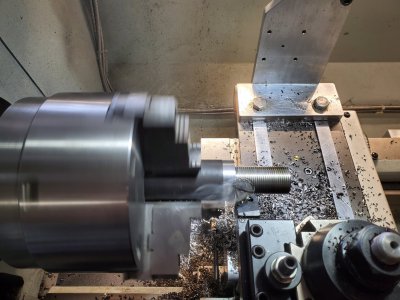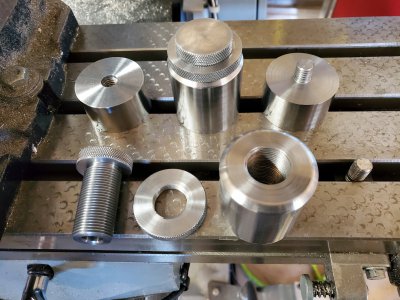I will not disagree with anyone in this thread, but I am going to share what I have experienced on my lathe, with my tools...
I bought some cheap carbide insert threading tools from Amazon with 5/8 shank. I was trying to thread 5/8 4140 stock with 18 tpi. I had 2.5 inches of stick out. I was going to use my live center, but decided not to because I couldn’t fit the tool with it. I took a scratch pass then proceeded with .005 doc. Everything was good until I hit .040 deep out of the .067 I needed to cut to hit minor diameter.
My economically oriented carbide set has a thread cutter... It cuts good threads, and would cut that thread. I have a hard time with it though, because the depth of cut that my lathe wants is where you're at. After the first one or two passes, five or so thousandths of infeed (10 on diameter, I'm using a radius dial). The problem is the cutter is not "sharp" enough to work well at that shallow of a depth of cut. Successful or otherwise, the tool isn't deep enough to work the way I wish it would. So my first reflection here is that I would be using a high speed steel cutter.
The tip of the tool broke off, but I continued because the thread looked ok and it was the very bottom of the tool.When I hit .050 it snapped even more, but very jagged,
I've broken the bottom off of inserts, but not the threading tool. (That one just breaks clean off.....) My belief is that when the bottom breaks off, even if the top looks good, feels good, and seems to work, the breaking force and deformation of the carbide that caused it came from the top of the tool. You can squeeze a few more cuts out of it. Maybe. But there's a break/crack/weak spot, or some other compromise to the structure of the carbide. It's dead when the bottom falls off. Like I said though, that's based on other inserts, NOT my threading tool, so for what it's worth.
but I’m pretty sure the thread was ruined at .045 before the insert broke the second time.
If your part is still in the chuck, the thread still has some tangible meat that needs to be removed, I've had success "picking up the thread" just a whisker behind where it was, by shifting the cross slide in and the compound out. Starting over with the infeed (on the compound), taking a few thousandths off the right hand side of the V, all the way down to where I left offf. Essentially, taking a smaller bite, and cutting off the rough finish off of the right hand side, so once you "hit" the bottom of the thread, you've still got the whole left side to cut, but you're at a fresh start with a clean finish to brace/support the tool on the non cutting side. I don't think it's a conventional method, but I've had success. You do loose your stops and your dial numbers, so either that has to be re-figured and reset, or you're doing it the cave man way with dead reckoning and a female test thread.
Just for perspective in making cuts easier/better, I know you're not doing this- I've found that I can cut 8TPI and coarser threads in tough materials by doing exactly that. Cut in until the lathe/cutter/setup isn't happy, and adjust the cross slide and compound "backwards, so that the next cut takes ONLY the right side of the thread, and go in again, right to the bottom, and repeat as necessary. That approach essentially takes your thread shaped form tool, and breaks it up to make cuts that are easier and lower pressure to take.
There's probably a science to doing that (in fact I know there is, it's called geometry, but I just haven't done the math). Just played with it. If you've got a "dead" part still in the chuck, well, that battle is lost, there's an opportunity there to see what can be done.
I was running 400 rpm by the way. My compound was set to 29deg with my qctp turned so it was at zero degrees. I advanced my depth with compound.
My question is, why didn’t this work? Was it too much stick out without support? Was it speed? Was it my process? Or I did everything wrong?
All the above, something else, and a little bit of black magic. If I were doing exactly what you're doing, based on your pictures and measurements, using high speed steel, I wouldn't need tailstock support. Using a carbide cutter with that (Which admittedly, while it's "ok", I don't think my reasonably priced carbide is a good as carbide gets...), there's more tool pressure, I'd support it. I know you're way within the "speed limit" already, but I'd probably be closer to 200 RPMs.
And I can't say enough... You've got a "dead part" there.... Trying to save it with a new tip might or might not be possible, plausible, or realistic, but you've got nothing to loose. If you save it, great. If it's still dead, thread that thing right down until there's nothing left, try different thinigs you wouldn't do to a good part. You'll burn up five or ten minutes until you run out of metal, but you'll learn something about what your material, your tool tool and your lathe likes and dislikes.



